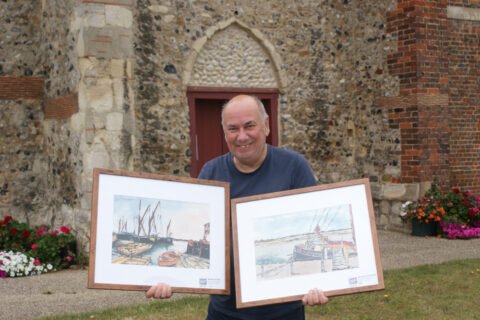In 2017, the Art and Culture Development Foundation (ACDF) was founded by the Republic of Uzbekistan’s president Shavkat Mirziyoyev, a leader known for his liberalisation policies.
This initiative, driven by the objective to promote and preserve Uzbekistan’s rich artistic and cultural heritage, is committed to supporting diverse art forms on a global stage. To realise this, ACDF is collaborating with partners—both local and international—who have the ability to revitalise historical narratives while preserving their essence. Their initiatives, including the restoration and reinvigoration of the nation’s ancient cultural and architectural heritage, are celebrating national identity and serving as a strategic tool for the modernisation of culture at large. Acknowledging that the history of a place cannot be narrated by a singular voice, the team is incorporating local and international interdisciplinary collaborations, conducted by teams of architects, historians, art historians, curators and experts in restoration.
The year 2023 proved to be a momentous period for ACDF, as it commissioned a series of notable exhibitions with international partners that captured global interest. Among these are The Splendours of Uzbekistan’s Oases: at the Crossroads of the Caravan Routes at the Louvre Museum in Paris (November 23, 2022-March 6, 2023); On the Roads to Samarkand, Wonders of Silk and Gold at the Arab World Institute in Paris (November 23, 2022-June 4, 2023); and Archaeological Treasures of Uzbekistan: from Alexander the Great to the Kushan Empire at the Staatliche Museen zu Berlin (May 4, 2023-January 14, 2024), showing artefacts from the ancient urban centre of Dalverzin Tepe, the Buddhist monasteries of Fayaz Tepe and Kara Tepe, and the Khalchayan palace. Some of these objects were recently featured in the exhibition at the Louvre Museum, but many were shown in Europe for the first time.

In architecture and design, presentations were made to define and celebrate Uzbek modernity. The Uzbekistan National Pavilion, Unbuild Together: Archaism vs. Modernity, at the 18th International Architecture Exhibition—La Biennale di Venezia (May 20-November 26, 2023 ) addressed different horizons of Uzbekistan’s architectural heritage as a potential tool to envision the future and a key element to challenge the concept of modernity. This presentation was augmented by Tashkent Modernism. Index, an exhibition that was part of Triennale Milano (April 17–23, 2023). The product of an intensive research effort conducted by an international team of architects, historians and experts in restoration, the show included photographs by Armin Linke and archival documentation, exposing the research narratives and preservation strategies in a bid to document, interpret and preserve the modernist architecture in Tashkent, Uzbekistan.

ACDF has an array of ambitious long-term projects in development, poised to redefine Uzbekistan’s cultural landscape. These initiatives include cultural events such as the launch of the Aral Culture Summit in 2024 and the inaugural Bukhara Biennial of Contemporary Art in 2025 as well as ambitious building projects in Tashkent like the reconstruction of the State Museum of Art by the acclaimed Japanese architect Tadao Ando, the opening of a Restoration Centre, a French Cultural Centre, and the transformation of a diesel station dating from 1912 into the Centre for Contemporary Art through the visionary work of Studio KO.

The Marrakech office of the French architecture firm Studio KO is overseeing the development of future buildings for the Artist Residences programme, situated in the historic neighbourhoods of Namuna and Hazrati Imam within the ancient city of Tashkent. Scheduled to open its doors in 2024, the Artist Residences will be hosting local and international artists, designers, artisans, curators and researchers. A hub of intersections, the residence will breathe life into woodworking, pottery, fabrics, printing and sound, fortified by symbiotic partnerships with master artisans. The impact of its programming will redefine the concepts of crafting, creating, contemplating, transmitting values and re-imagining collective memories.
Central to the vision and mission of Artist Residences is its commitment to nurturing artistic and research practices deeply rooted in local communities, fostering meaningful dialogues through active participation. To kick off this effort, a three-day long Mahalla art weekend festival in Namuna Mahalla, a future residency site, was launched in summer 2023. The festival aimed to foster community relationships and address common issues through contemporary art. The festival’s programme, developed with input from the local community, showcased projects by young Uzbek artists, including collaborations with children. The event also featured screenings of video pieces by young artists and filmmakers from Uzbekistan, as well as open discussions of projects by emerging local artists.

Gayane Umerova, the executive director of ACDF, shares insights into the organisation’s strategic initiatives, “Our current projects have a foundation that was laid six years ago when ACDF was established. We recognised the need to make an impact and to be recognised on a global scale. Initially, we focused on the concept of the State Museum of Art, followed by the Centre for Contemporary Art. Over time, we realised the importance of creating content ourselves, exemplified by the artist-in-residence programme.”
Umerova further explains that these projects have evolved in a sequential manner, with each one emerging as a natural progression. “Our engagement with architecture led us to participate in the Venice Biennale,” she adds. “Our driving force isn’t a singular idea, but rather a deeply rooted necessity to build infrastructure and showcase Uzbekistan to the world.”
In response to the ongoing challenge of retaining younger talents in Uzbekistan, she notes: “We initiated this journey not with a grand strategy in mind, but with the goal of empowering the younger generation to contribute to their country. Many of our young people go abroad for education and don’t return because they struggle to find opportunities to apply their knowledge and to be heard. The creative economy is at the forefront, and our focus is on identifying and nurturing talent from within Uzbekistan.”
Umerova emphasises the importance of creating a vibrant cultural atmosphere, including festivals, exhibitions and ambitious plans like the Bukhara Biennial of Contemporary Art. She elaborates, “In Bukhara, we aim to breathe new life into the many beautiful madrasas through cultural initiatives and traditional craftsmanship. Additionally, we are collaborating with the Michelangelo Foundation on the Homo Faber project. It is a significant endeavour for us as it recognises traditional crafts in Uzbekistan, which have historically been undervalued in terms of design and artistry.”
Since the Soviet era, concerted efforts have been undertaken to preserve and revive architectural landmarks tied to the region’s extensive ancient and mediaeval history. The architectural landscape of the 1960s-80s, characterised by modernist designs projecting the vision of a forward-looking society, remained unrecognised as heritage. The advent of a market economy and Uzbekistan’s independence in 1991 rendered the architecture of the preceding three decades, with its emphasis on societal issues and resource efficiency, obsolete.
In the present day, Tashkent’s modernist stratum is gaining recognition as a distinctive artistic, cultural and social phenomenon, serving as a prime conduit to unveil the nuanced character of Central Asia’s modernisation. Beyond being just another “peripheral case” within the realm of diverse modernities or a mere pin on the global map of 20th century architectural modernism, this architectural legacy holds relevance on the global cultural stage.
Most recently, the ACDF initiated the comprehensive research project “Tashkent Modernism XX/XXI” led by the Milan-based architecture studio Grace, which was founded by the architect Ekaterina Golovatyuk. This dedicated research team brings together architects, historians, and preservation experts from around the world, including the noted art historian and curator Boris Chukhovich, Laboratorio Permanente, and the Department of Architecture and Urban Studies at Politecnico di Milano.
As a strand of the research and preservation endeavour, ACDF organised the first conference on the preservation of Tashkent’s modernist architecture titled Where in the World Is Tashkent (October 18-19, 2023) in homage to the architect and historian Jean-Louis Cohen (1949-2023), a significant contributor to this project.
The roots of Tashkent’s modernist history can be traced back to the ambitious urban renewal plans of the early 1960s, when the country was part of the Soviet Union, which aimed to bring about a radical transformation of the city. A devastating earthquake in 1966 accelerated the implementation of these plans as large parts of Tashkent were reduced to rubble. Architects from across the Soviet Union collaborated with local experts to reconstruct the city, resulting in a distinctive form of architectural modernism that seamlessly blended elements of Islamic architecture, local craftsmanship and cutting-edge engineering innovations of the era. In the years following the dissolution of the Soviet Union, a significant portion of this architectural heritage fell into disrepair, underwent redevelopment or faced the threat of demolition. As more and more of these historic structures were vanishing, ACDF launched a large-scale campaign to raise awareness about their cultural significance and to protect them from imminent destruction.
The conference’s objective was to elevate awareness regarding the architectural legacy of Tashkent and to draw upon the expertise of professionals worldwide. It aimed to facilitate a dynamic exchange of ideas with the ultimate goal of implementing a comprehensive strategy for preserving Tashkent’s architectural heritage. Discussions revolved around the reimagining of public spaces, the pivotal role of cultural institutions in critically revising architectural history, and the challenges and prospects tied to Tashkent’s quest for UNESCO World Heritage status. The conference featured a keynote lecture by the architect Rem Koolhaas and talks by other distinguished speakers including the general director of Italy’s Pinacoteca di Brera and Biblioteca Nazionale Braidense, James M. Bradburne; the principal of the Johannesburg-based design/research studio Counterspace, Sumayya Vally; and the director of the Anthropology and History Museum of Mexico, Eduardo A. Escalante Carrillo.
Responding to a question regarding the key factors behind successful strategies that fuel cultural growth both domestically and on the international stage, Umerova offers insights: “Initially, we embarked on this journey without a predefined strategy, which makes it challenging for me to pinpoint one. However, we have come to recognise the importance of having a broader perspective. We are actively involved in numerous initiatives centred around inclusivity, a vital aspect we believe was previously lacking in Uzbekistan. Our focal point is Tashkent, recognising that our strategies need to be thoroughly tested before broader implementation.”
She continues, “One of our current endeavours in Tashkent is the Tashkent Modernism project, which seeks to engage with the city’s urban fabric and pedestrian zones. Tashkent was once a sprawling city where one could traverse from one end to the other on foot. Unfortunately, this has changed due to increased car traffic and alterations in road layouts. Exploring the theme of Tashkent’s modernism has revealed its ingenuity. Our plan involves revitalising all modernist structures. Next year, we will be submitting UNESCO nominations to have these buildings recognised as part of World Heritage.”
Summing up the overarching strategy for Uzbekistan, Umerova concludes: “Our goal is to modernise, to enhance social cohesion, to foster a welcoming environment and to ensure our presence on the global art stage.”
Uzbekistan’s increasing focus on art and culture could indeed fortify its role in Central Asia by promoting its rich heritage and fostering cultural exchange. While it’s too early to definitively predict if it will become a beacon in the region, its efforts certainly have the potential to make a significant impact on regional diplomacy through the soft power of art, architecture and heritage.













